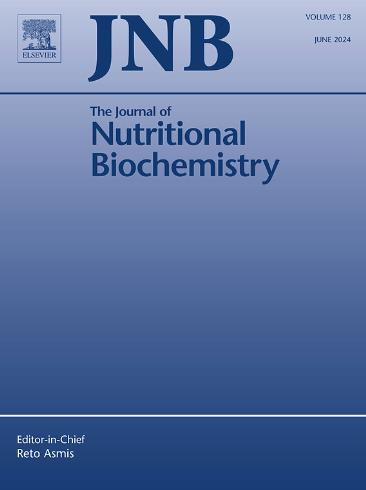黄烷-3-醇对小鼠卵巢切除所致骨质流失的影响及其可能机制。
IF 4.8
2区 医学
Q1 BIOCHEMISTRY & MOLECULAR BIOLOGY
引用次数: 0
摘要
据报道,黄烷-3-醇(FLOs)具有多种健康益处,其中大部分通过肠道微生物群到达结肠进行发酵。本研究旨在研究FLOs对骨骼健康的影响,并评估肠道微生物群对这些影响的影响。使用卵巢切除引起的小鼠骨质流失模型,动物被给予低剂量或高剂量的FLOs,或FLOs与抗生素鸡尾酒(Abs+FLOs)的组合。与对照组相比,补充FLOs组的骨形成血清标志物以及micro-CT测定的骨质量都有所升高,特别是在与抗体联合使用时。此外,FLOs和Abs+FLOs干预均显著提高了雌激素水平。然而,与单独添加Abs的组相比,没有检测到FLOs对这些标记物的额外影响。16S rRNA测序数据分析显示,骨质疏松小鼠中某些操作分类单位(如s__unclassified_Clostridia_UCG_014, s__unclassified_Ruminococcus和s__unclassified_Lachnospiraceae)的丰度显着降低,但在给予FLOs后有效逆转。转录组学分析结合KEGG富集分析表明,Adrb3、Gdf10 (BMP3)、Fosb和Cxcl2以及PPARα/PGC-1/UCP1信号通路可能介导黄烷醇对骨代谢的调节。总的来说,该研究揭示了黄烷-3-醇的骨保护特性,表明这些作用可能取决于肠道微生物群的存在。本文章由计算机程序翻译,如有差异,请以英文原文为准。
The effect of flavan-3-ols on ovariectomy-induced bone loss in mice and the potential mechanisms
Flavan-3-ols (FLOs) have been reported to confer various health benefits, the majority of which reaching the colon for fermentation by gut microbiota. This study sought to examine the effects of FLOs on bone health and to evaluate the influence of gut microbiota on these effects. Using an ovariectomy-induced bone loss model in mice, the animals were administered either a low or high dose of FLOs, or a combination of FLOs with an antibiotic cocktail (Abs+FLOs). Compared to the control group, serum markers of bone formation, as well as bone quality as determined by micro-CT, were elevated in the groups supplemented with FLOs, particularly when combined with Abs. Furthermore, both FLOs and Abs+FLOs interventions significantly improved the levels of estrogen. However, no additional influence of FLOs on these markers was detected compared to the group supplemented with Abs alone. Analysis of 16S rRNA sequencing data revealed that the abundance of certain operational taxonomic units, such as s__unclassified_Clostridia_UCG_014, s__unclassified_Ruminococcus, and s__unclassified_Lachnospiraceae, was significantly reduced in osteoporotic mice but effectively reversed following the administration of FLOs. Transcriptomic analysis coupled with KEGG enrichment analysis indicated that Adrb3, Gdf10 (BMP3), Fosb, and Cxcl2, along with the PPARα/PGC-1/UCP1 signaling pathway, may potentially mediate the regulation of bone metabolism by flavanols. Collectively, the study uncovers the osteoprotective properties of flavan-3-ols, indicating that these effects may depend on the presence of gut microbiota.
求助全文
通过发布文献求助,成功后即可免费获取论文全文。
去求助
来源期刊

Journal of Nutritional Biochemistry
医学-生化与分子生物学
CiteScore
9.50
自引率
3.60%
发文量
237
审稿时长
68 days
期刊介绍:
Devoted to advancements in nutritional sciences, The Journal of Nutritional Biochemistry presents experimental nutrition research as it relates to: biochemistry, molecular biology, toxicology, or physiology.
Rigorous reviews by an international editorial board of distinguished scientists ensure publication of the most current and key research being conducted in nutrition at the cellular, animal and human level. In addition to its monthly features of critical reviews and research articles, The Journal of Nutritional Biochemistry also periodically publishes emerging issues, experimental methods, and other types of articles.
 求助内容:
求助内容: 应助结果提醒方式:
应助结果提醒方式:


